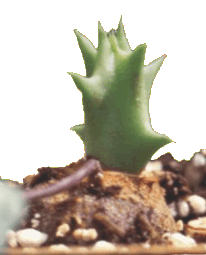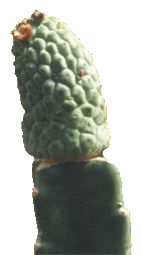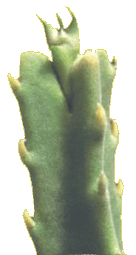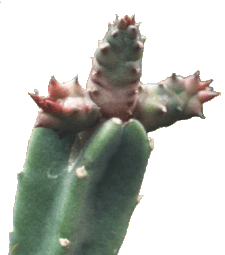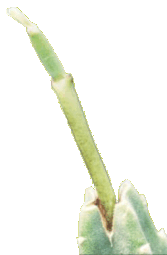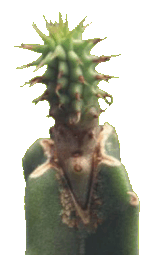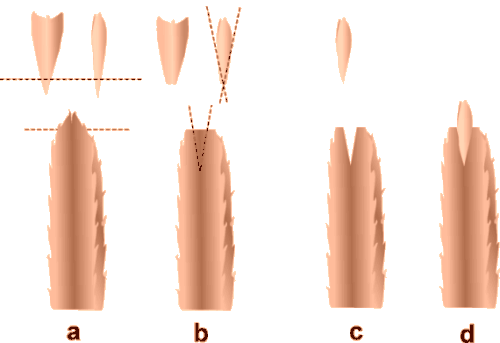Grafting the Stapeliads |
|
|
Larryleachia picta on Stapelia
gigantea stock |
|
|
Orbeopsis melanantha on Ceropegia
linearis ssp. woodii tuber |
The first plants I tried grafting were cacti. At the beginning, I experimented with bigger plants and strong stock plants, later I moved to more tender plants. As I now think back of what I used to do, smaller plants were easier to handle, besides, a straight cut is easily accomplished. Additionally, the grafts heal better. Grafting seedlings was the next step, usually on some Echinopsis sp. rooted cutting. The success rate was high, even with some tenths of mm small seedlings of the miniatures Aztekium ritteri or Strombocactus disciformis.
A few years ago I started with cultivation of stapeliads and the rest of asclepiads more intensively. Overwintering of some species proved problematic (Tavaresia spp., Hoodia spp., Larryleachia (Trichocaulon) spp., …), and the black rot also took its toll, sometimes even during the growth season. Furthermore, cuttings of some species (Hoodia spp., Quaqua mamillaris) root with great difficulties, if at all. Grafting is the only means of vegetative propagation in such cases.
The seedlings of stapeliads are quite sensitive during the first few weeks. In contrast with other succulents or cacti, seeds are difficult to obtain and even if they are then only a few - the loss of a seedling thus represents a considerable threat. The thought of grafting young and sensitive seedlings came to my mind.
|
|
Duvalia compacta on Stapelia gigantea
stock |
|
|
Successful grafting |
The stock
Before we begin with grafting, corresponding stock must be available. In my opinion, the tubers of Ceropegia linearis ssp. woodii are the best alternative. Tubers of other ceropegias might also be useful, but most are not as easy to propagate. Beside the tubers, I also use rooted stem cuttings of Stapelia gigantea. Other growers report on using other stocks I have no experiences with, so far: Echidnopsis cereiformis [1], E. dammanniana [5], Huernia schneideriana [1], H. macrocarpa hybrid [1], ×Luckhoffia beukmanii [1, 6], Tromotriche hybrid [1], Caralluma burchardii [3], C. joannis [3], C. speciosa [6], Pachcymbium carnosum [3], Stapelia grandiflora [3], Ceropegia sandersoni [4], C. rendalli [6]. The choice very much depends on the author, though most first name C. linearis ssp. woodii and S. gigantea.
Stem stock is best chosen according to the resistance to fungal diseases and black rot, a bacterial disease. Of course, there is little use of stock plants which root with difficulties.
The side stems to be used as stock are best cut or broken away from the main stem at the narrowest point, dried and potted into the rooting medium, preferably already into pots to be used later, so that after rooting they are not disturbed by additional repotting. If the roots are not present already, stapelias root very quickly. The cuttings must be kept moist, since only strong and well watered stems are useful.
The tubers of ceropegia are also prepared easily. Stem cuttings are put onto rooting medium, they may even be covered partly. At the nodes, little tubers soon start to form. The containers are best kept in shade or half-shade - the young plantlets are not happy in full sun. They can be watered quite frequently and when the first tubers and roots are visible, some fertiliser can be added. It appears that they grow faster if covered with substrate completely. When about 1 cm in diameter, they can be repotted individually into small pots, with the tip somewhat above the edge of the pot, so that it can be cut off while grafting. Square pots are best, since rubber bands for immobilisation of scions can be used more easily. Smaller tubers are best kept aside until somewhat bigger, in any case, patience is called for until the plant's roots develop properly.
Since most losses occur during winter, it is sensible to have some grafting stock of different species at hand, keeping them warm and growing by continuous watering.
|
|
Hoodia bainii |
|
|
Ceropegia rupicola |
The grafting
Before we start with grafting, the stock, the plants to be grafted, and the corresponding tools should be prepared. The stock should be well watered a day or two in advance. A sharp knife or a razorblade is essential. For disinfecting of tools, alcohol (I use ethyl alcohol) is also required, and some cotton-wool may be useful. In order to keep the grafts in place, I use rubber bands or square weights made of glass.
Flat grafting of adult plants
Stems of adult plants are best grafted on ceropegia tubers. The stock is first cleaned and the superfluous substrate removed. The tuber is cleaned with some cotton-wool, soaked with alcohol. Rests of soil and probably also some infectious germs are thus removed. With a clean, disinfected and sharp knife (I never use the snap-blade knives since they are hard to clean due to the grooves) I cut off the tip of tuber. Some of the ceropegia stems can be left growing to help nourish the stock. The cut must be smooth and even and has to be done in a single step. The resulting wound should be just a little bigger than the stem to be grafted, so that not much sap is lost.
The scion should also be prepared properly and even disinfected. With a single movement an even and smooth cut is made and the stem put on the stock. There is no need to take care of the vascular bundles, since the stock has none, so the scion can be put anywhere on the cut of the tuber.
Short stems, about 1 cm long, are easily grafted, since they can be held in place with a rubber band. Longer stems are more difficult to handle in this respect, since they are quite unstable. Luckily, a very good solution was recently described in Asklepios [2]: a soft wire is bent around the stem and a hook is formed at one end. With a rubber band attached to the hook and around the pot, the stem is kept in place firmly.
Freshly grafted plants should be kept in shade to let the wound heal and the graft strengthen. After a few days (two are usually already enough), the rubber bands can be removed. If a wire was used, some more care is called for. Then the plant should be left aside for a few more days.
For adult plants, other understocks are useful. Due to the lack of ceropegia tubers, I once used a Stapelia gigantea stock for a Larryleachia (Trichocaulon) picta scion, since I was about to lose the whole plant due to a mid-winter attack of black rot. Once the graft healed well, the scion grew fast and the understock also fattened visibly.
When grafting on stapeliads (cf. the above list), the stems can be disinfected with a piece of cotton wool soaked in alcohol. With a sterile and sharp knife, the stem is cut with one movement. The sides (ribs) can be cut back a bit, as is usual with cacti. The scion can be handled the same way. The two parts are joined so that vascular bundles of the two cuts overlap. The scion is then immobilised in one of the described ways.
The grafted plant should be kept in shade for a few days and watered well, until the scion joins with the understock well. Some authors expressed the opinion that stapelias are only appropriate as a temporary stock, since main stems die back in time while side shoots grow on.
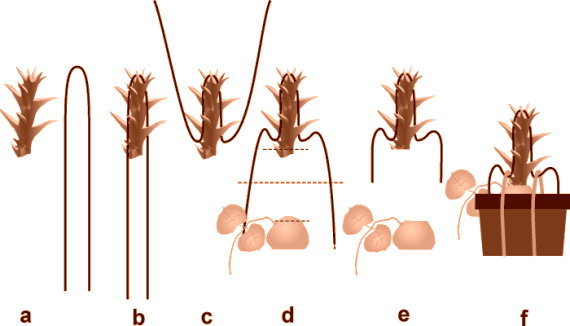
Flat grafting of large stems
Split grafting of seedlings
Seedlings of stapeliads can be quite sensitive, especially of those species we only have two or three seeds of. The loss of one plantlet may be critical in such a case. Seedlings growing in humid and warm conditions may easily be attacked by black rot. Since usually the seedling succumbs to it, I started considering different ways of how to save them. Since they are tender and tallish, flat grafting on ceropegia tubers is less appropriate. In the same way, I excluded grafting on stapelias. After a time I decided to try split grafting - after all, I already had some experience with grafting shoots of Christmas cacti (Schlumbergera truncata) on Harrisia sp. stock.
I usually take a well rooted cutting of a Stapelia gigantea as understock. First, I disinfect it and cut it 2-3 mm below the top (a), across the stem, with a sharp blade. The second cut, perpendicular to the first one and right through the middle of the stem, should be a bit less than 1 cm long (b).
The scion is first cut across the stem (a). If infected with black rot, so much tissue should be cut away until the remaining stem appears healthy without the typical black dots. Then, the scion is cut along the sides in the form of a wedge (b). A sharp disinfected razorblade should be used during this operation so that the tender tissues are as smoothly cut and as well preserved as possible. The scion is then inserted into the vertical cut of the stock, somewhat out of the centre to assure overlapping of vascular bundles. It can be immobilised with a rubber band or in some other way, though this is rarely essential since the scion is usually quite stable. The plant is then kept in the shadow for a few days to wait until the graft heals. If the procedure is successful, the scion will grow fast and in time the side shoots can be cut away and rooted separately.
In a few cases new growth is absent, though the graft seems healthy. The scion grows only slowly if at all. If one is impatient, the seedling can be grafted anew immediately. I usually wait until it strengthens up a bit and then repeat the grafting.
In this way, I successfully grafted and saved seedlings of Ceropegia, Huernia, Stapelia, Duvalia, Orbeopsis, Hoodia, Larryleachia (Lavrania, Trichocaulon), Caralluma, Angolluma, and of a few additional genera that momentarily escaped from my mind.
Even weak side shoots of adult plants can be grafted in this way, with encouraging success.
Split grafting of seedling
Conclusions
Grafting stapeliads can be undertaken either to help tender seedlings survive the first critical weeks, or to provide a resistant base for sensitive plants. Grafted plants, especially those with stapelias as understock don't have a particular aesthetic appeal. If it disturbs us, the well developed scions can be cut off and rooted, or at least the main stem is left for production of further cuttings.
If the stock is tuberous, the wound can be buried in sand so that the plant looks as if it grew on its own roots, so the stock does not disturb the eye. In this case, one has to prevent waterlogging at the surface of tuber. With time it may happen, that the scion develops its own roots.
